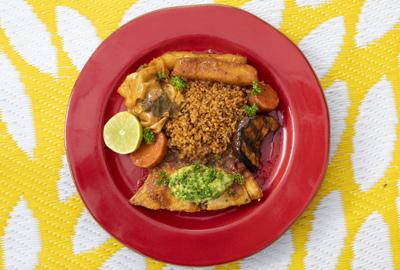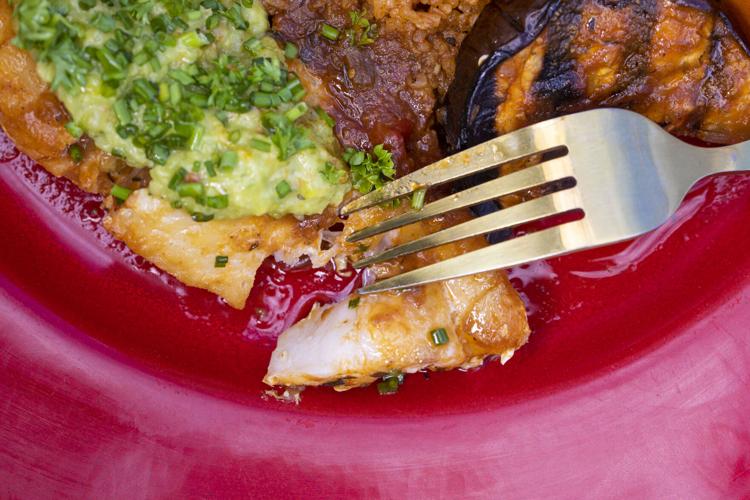This might be the last restaurant review in which I sing the praises of goat, but I hope not. As I argued in my recent review of Ma’am Saab, it’s an underappreciated meat.
Here’s Exhibit No. 2: the goat egusi and ndolé stew ($25) at Bintü Atelier, which opened nine months ago in Charleston’s East Side. Egusi are melon seeds, which are toasted, ground and stirred along with crawfish powder into a base of smoked red peppers and tomatoes, imparting a wonderful, thick, almost grainy texture. The ndolé is spinach, and the tangled green strands add a fine bitter bite.
No bones about it: this is an excellent stew. Well, there are a few bones — some long and slender, others thick nubs — but the meat slips right off them. The goat is a touch ropy but not at all tough. Served alongside is a ball of fufu, a soft, sticky dough made from mashed cassava that you pinch off and dunk into the sauce as a sort of edible spoon.

Mafé, a groundnut stew with chicken.
Goat stew is just one of the intriguing West African specialties you’ll find at this much-needed newcomer. It’s the first Charleston restaurant from Binta N’Daw Young, who operated a successful catering business and a sauce company in New York City before the pandemic prompted her and her husband, Tracey Young, to head south.
Born in Dakar and raised in the coastal city of Saint-Louis, N’Daw Young is of Senegalese and French descent. Both her grandmothers were caterers, one in Dakar and the other in France, and N’Daw Young cooked at Chez Nous when she first arrived in Charleston. If those French influences left a mark, though, they’re subtly in the background — perhaps in the lamb confit, served with long strips of caramelized onion over couscous or broken rice that anchors the yassa lamb entrée ($27)?
Front and center are the techniques and complex flavors that characterize West African cookery, like thickening stews with ground seeds and infusing onions and peppers with the silky, earthy notes of palm oil.
Bintu’s signature plate is thiéboudieun ($25), a beloved Senegalese dish. It’s built on a foundation of broken rice cooked in jollof sauce, a rich blend of tomato, vegetables and fish broth. Arrayed around the rice are a pile of braised carrots, cabbage and eggplant along with a hefty slab of grouper enrobed in thick red sauce. Beneath the fork, that fish slips into deliciously delicate white chunks, and the rice is at once tender and chewy — a remarkable combination.
N’Daw Young sometimes sneaks in a dish from various parts of the African diaspora, like moqueca de Bahia ($29), a Brazilian stew fragrant with coconut and palm. Vivid yellow in color and served over white rice, it brims with fresh shrimp and chunks of tender grouper.

Egusi with goat meat.
As the Atelier in the name suggests, N’Daw Young’s operation is something of a workshop. Since its quiet launch last June, she’s expanded the scope step by step. At first, the food was primarily for carryout customers, with just a handful of tables outdoors in the small courtyard. Over the months that followed, she expanded the hours of service and added more seating on the patio, then created a small indoor dining room in an adjoining yellow building.
Most important, N’Daw Young has built out her initially slim menu a dish or two at a time. As of my last visit, it consisted of five small plates and seven mains, which is enough to create a tyranny of tempting choices.
On the smaller side are skewers of fried shrimp ($17), clad in golden-brown jackets of millet and fonio (a quinoa-like grain). Ndambé ($15) is a thick stew of black-eyed peas and spinach, served as a dip with grilled flatbread alongside. Fulani chicken wings ($15), striped black from the grill, are accompanied by smoked cumin, green nokoss or mango-tamarind sauces.
The small plate star is Bintu’s crab rice ($18), which is a bit different than its Lowcountry relative. It has the same base of tender rice studded with red pepper and green onions, but these grains are short and sticky, and they sing with the sweet richness of dried conch and the heat of shito paste. Instead of flaked and mixed in, the crab is a whole soft shell, lightly fried and laid over the top. With each forkful, the juices meld into the savory, slight spicy rice, creating an irresistible bite.

Bintu Atelier’s new interior section is covered with local and African art and decorations.
For now, at least, the Atelier remains a fairly small-scale operation. It’s open four days a week, Thursday through Sunday, with lunch starting at noon and a break at 3 until dinner service begins at 5 p.m.
The rather quirky space at 8-D Line St., which formerly housed Dos Taqueria, is not a single building but a small complex linked by the outdoor patio. The kitchen is in a two-story single house set back from the sidewalk, and it’s flanked by two low, narrow buildings — the pale blue one on the left housing the takeout counter and the yellow one on the right the small dining room.
There’s nothing fancy about the dining room, except for the elaborate, doily-like placemats. The servingware is a mix of cherry red plates, black bowls and plain white platters, and the tables and chairs have metal frames and brown wooden slats. The layout requires the servers to exit the front door and head across the courtyard to fetch drinks or plates from the kitchen. There can be long pauses between appetizers and main courses, but that seems in line with the relaxed mood of the place.

Shito Spicy Crab Rice plated on an outside table at Bintu Atelier.
In recent years, Charleston has seen a vibrant influx of culinary traditions from around the globe, and one could cast Bintü as just one more point in the trendline. In many ways, though, it’s a significant outlier.
For starters, there’s no pop-culture fusions or playful deconstructions of traditional dishes. There’s no glowing neon lights and no thumping dance music. Bintü has no craft cocktail program and not a single craft beer (or any beer, for that matter.) Instead, there are beverages made from fresh-squeezed fruit and delivered to the table in short, square-sided glass bottles (each $6) — sorrel (hibiscus) iced tea, passionfruit, pineapple-ginger and soursop.
I had no idea what soursop was, so I asked. I’m glad I did. It’s a prickly green fruit native to the Caribbean and American tropics. The squeezed juice is cloudy and slightly sweet, with a fruity flavor akin to pear but with richer honey notes — a refreshing prelude to the meal and a fine accompaniment to the bold, savory dishes.

Bintu Atelier’s original kitchen and outdoor dining area, as well as the new inside dining room on the right, can be seen from across Line Street on March 7 in Charleston.
More than anything, Bintü Atelier feels more essential and deeply rooted in the city than many of the other newcomers. Last summer, N’Daw Young told Post and Courier Food Editor Parker Milner that she and her husband decided to remain in Charleston and open their own restaurant because “this city was to me the connection that we were looking for to Africa.”
The stew may use goat instead of oxtail, and it may be thickened with ground melon seeds instead of benne, but the flavors and textures still seem familiar. The jollof rice is familiar, too, though it’s even juicier and — dare I say it? — even more flavorful than red rice, its Lowcountry cousin. The palm oil and crawfish powder add unexpected notes, but shrimp, peanuts, okra and broken rice — or “middlins” as they’re often called here — are the foundational elements of Lowcountry cuisine.
It’s one thing to read about the deep connections between West African and Lowcountry cooking, but it’s another to actually taste them. You can do precisely that at Bintü Atelier, which makes it an essential visit for anyone exploring the roots of Charleston’s cuisine.
Photos: Bintu Atelier brings African cuisine to Charleston
Bintu Atelier brings cuisine from Africa to the Lowcountry in a small shop on Line Street. Now with their completed indoor dining area customers can pick between that and an outdoor courtyard area.

























